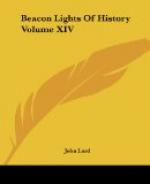Darwin’s book on the “Expression of Emotion in Men and Animals” was published in the autumn of 1872. This had been intended to form a chapter on the subject in the “Descent of Man,” but as soon as Darwin began to put his notes together he saw that it would require a separate treatise. In July, 1875, appeared the book on “Insectivorous Plants.” The fact that a plant should secrete, when properly excited, a fluid containing an acid and ferment closely analogous to the digestive fluid of an animal, was certainly a remarkable discovery. In the autumn of 1876 appeared “The Effects of Cross and Self Fertilization,” a work in which are described the endless and wonderful contrivances for the transportation of pollen from one plant to another of the same species. About the same time was brought out an enlarged edition of the “Fertilization of Orchids,” originally published in 1862. Among the minor works issued during the later years of Darwin’s life may be mentioned particularly the little book on “The Formation of Vegetable Mould through the Action of Worms.” This was the outgrowth of a short paper read before the Geological Society more than fourteen years before.
In order to appreciate the enormous amount of research accomplished by Charles Darwin, it is needful to keep in mind the conditions of ill-health under which almost continually he worked. For nearly forty years he never knew one day of the health of ordinary men. His life was one long struggle against the weariness and drain of sickness. During his last ten years there were signs of amendment in several particulars, but a loss of physical vigor was apparent. Writing to a friend in 1881, he complained that he no longer had the heart or strength to begin any prolonged investigations. In February and March, 1882, he frequently experienced attacks of pain in the region of the heart, attended with irregularity of the pulse. On April 18 he fainted, and was brought back to consciousness with great difficulty. He seemed to recognize the approach of death, and said, “I am not the least afraid to die.” On the afternoon of Wednesday, April 19, he passed away. On April 26 he was interred in Westminster Abbey. The funeral was attended by representatives of France, Germany, Italy, Spain, and Russia, and by delegates of the universities and learned societies of which he had been a member. Among the pall-bearers were Sir John Lubbock, Sir Joseph Hooker, Professor Huxley, Mr. A.R. Wallace, Mr. James Russell Lowell, the Duke of Argyll, and the Duke of Devonshire. The grave is appropriately placed in the north aisle of the nave, only a few feet from the last resting-place of Sir Isaac Newton.




